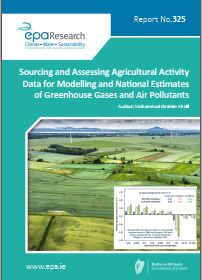Research 325: Sourcing and Assessing Agricultural Activity Data for Modelling and National Estimates of Greenhouse Gases and Air Pollutants
Author: Mohammad Ibrahim Khalil
Summary: This project aimed to inform efforts at combating climate change as a core national priority in the pursuit of a sustainable, low carbon economy in compliance with international obligations to reduce emissions of greenhouse gases (GHGs) and air pollutants and increase soil organic carbon (SOC) sequestration.

Identifying Pressures
This project aimed to inform efforts at combating climate change as a core national priority in the pursuit of a sustainable, low carbon economy in compliance with international obligations to reduce emissions of greenhouse gases (GHGs) and air pollutants and increase soil organic carbon (SOC) sequestration. It identifies practical approaches to the reporting requirements, as well as technological options for inclusion in mitigation policies, adaptation strategies and assessment. The EPA has the overall responsibility for the timely estimation and reporting of reactive gas emissions and their uncertainty and implementation of a quality assurance/quality control system. The use of more sophisticated models with high-resolution climatic, soil and other activity data, together with disaggregated emissions reporting, will be important to reduce uncertainty and introduce more flexibility into the inventories to better reflect mitigation measures.
Informing Policy
Signatory nations to the United Nations Framework Convention on Climate Change (UNFCCC) and the Convention on Long range Transboundary Air Pollution (CLRTAP) have agreed to report their national emissions of GHGs and air pollutants annually using the Intergovernmental Panel on Climate Change (IPCC) and United Nations Economic Commission for Europe (UNECE) guidelines. This project aimed to identify improved methodologies for upscaling from site to national scales and to identify the reporting requirements for agricultural systems. This, in turn, can inform the development of measures under the Common Agricultural Policy and the rural development and environmental regulations and directives of the EU, which have a strong influence on agriculture and its impact on environmental variables and their indicators. These could have strategic importance
for science, technology and innovation in Ireland and the improved environmental technologies required to cope with EU and international policies on emissions reductions and enhanced carbon sequestration. Future initiatives should include improving the collation of and access to measured/collected activity data to enable researchers and modellers to validate emerging models.
Developing Solutions
This project aimed to supplement EPA activities focused on improving national inventory reporting/ National Atmospheric Inventory System reporting through the development of novel methodologies and computational protocols. This was undertaken as it is not possible to directly measure GHGs, atmospheric pollutants and SOC covering all agricultural lands and associated management practices, including the impact of land use/land cover change over large areas and for extended
periods of time. This work sourced, collected and assessed agricultural activity data, analysed their uncertainty and developed proxies, leading to recommendations for filling some research gaps and for the improved estimation of emissions of GHGs and atmospheric pollutants. The use of a process-based model provides a potential solution for more robust emission accounting and reporting of SOC estimates with reduced uncertainty. The added advantages of this approach are a potential ability to
simulate site-specific information at national and even global levels and to identify mitigation strategies and GHG offsetting mechanisms. However, further research is required to develop relevant methodologies/procedures and enhance model performance in collaboration with the EPA inventory team to improve inventory estimates and UNFCCC/UNECE reporting.